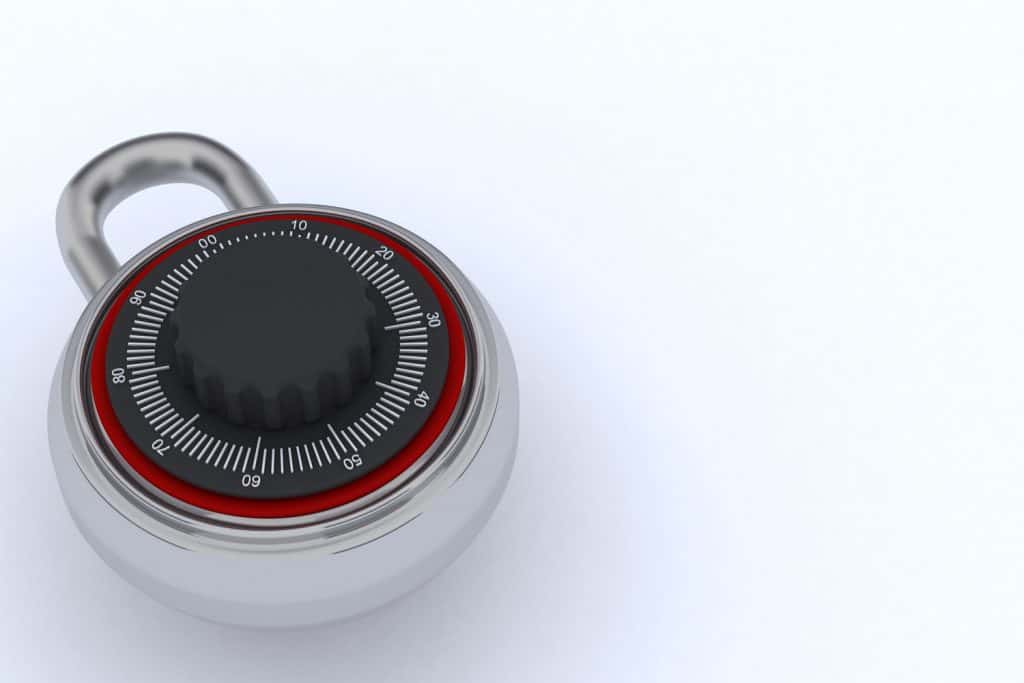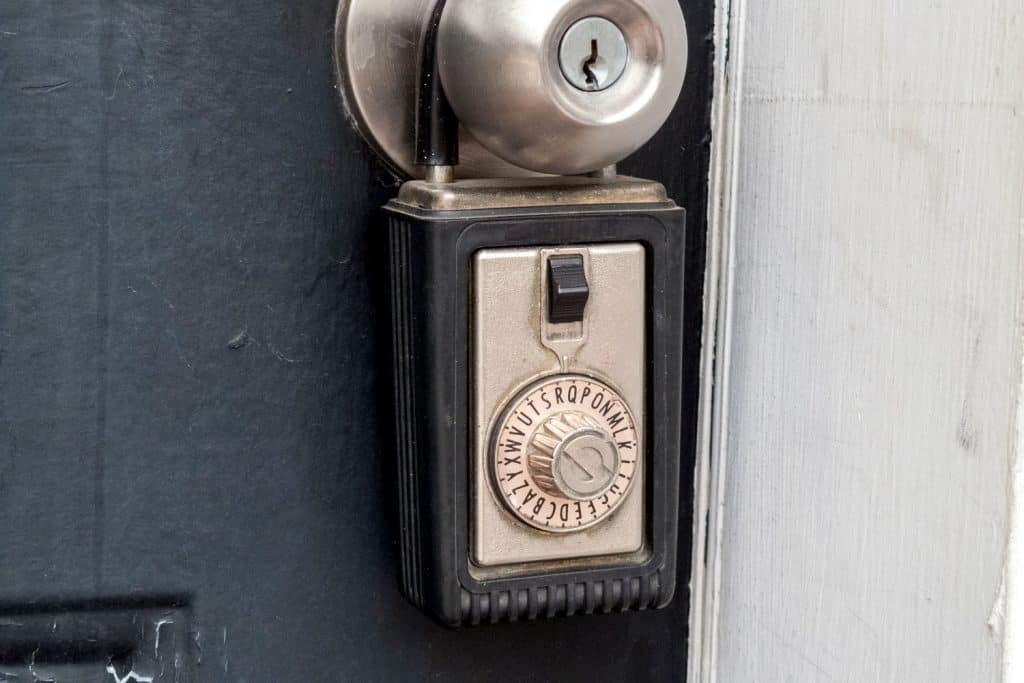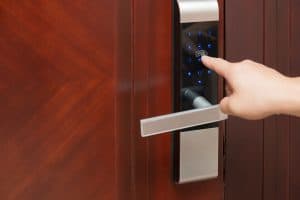Sometimes, a combination lock can malfunction and becomes difficult to open. You might even encounter an instance wherein inputting the correct combination won't open the lock. So what should you do if your combination lock becomes stuck? We researched and asked different experts to give you the answer to that question.
A combination lock can become stuck because it needs lubrication. Here are the steps to release it from its being stuck:
- Tap the different areas of the combination lock to loosen wedged dirt and debris.
- Spray the lock’s internals with pressurized air.
- Apply the correct lubricant.
- Test the lock if it now works without hitches.
It's a fairly straightforward procedure to release a combination lock that's stuck. But you should also take note of specific details in the process to reduce the amount of time and effort you spend on this project. Keep reading to know these specifics, along with information about the correct lubricants to use on locks.

How To Fix A Stuck Combo Lock

Here are the items you need for this task, along with the steps to follow:
What You’ll Need
- Safety glasses
- Hammer
- Pressurized air
- Lubricant
Step-By-Step Guide
- Put on your safety glasses or goggles.
- Use the hammer to give the lock a few firm yet non-destructive taps on the curved shank and both sides of the combination lock.
- Spray pressurized air into the lock shank and any holes in the lock's top area.
- Repeat steps 2 and 3 until you feel the combo lock loosening.
- Spray lubricant into the shaft and the keyhole.
- Insert and twist the master key to check if the lock is now working.
- Put the lock in the locked position again, and test the registered combination to see if it opens.
Does WD-40 Loosen Locks?
WD-40 can help loosen locks. But be wary as this solution can gunk up locking mechanisms. It’s because the WD in the product stands for ‘water displacement,’ and its primary use is to act as a solvent or rust dissolver.
For more information about applying this product on a lock, read through this post: Should You Spray WD-40 In A Lock?
What Is The Correct Lubricant To Use On Locks?
Aside from WD-40, you can use alternate options to lubricate locks to fix and prevent them from getting stuck. Some ideal choices include:
- White lithium grease: A substance with reasonably high resistance against inclement weather, making it a good choice for smoothening outdoor combination locks.
- Graphite: The material commonly used as pencil lead. You can use graphite from pencils to lubricate combination locks if you’re in a pinch. Albeit it can become quite messy to work with.
- Silicone spray: This slippery oil often has minimally-reactive properties, which means it can smoothen relatively anything it touches. But since it’s a type of oil, surfaces can become water-resistant, which may remove water-based paint used on locks.
- Teflon: Considered to be the best lock lubricant, this compound is hydrophobic. It means liquids don’t stick to it, allowing optimal and safe smoothening to combination locks and other surfaces.
Click here to see this non-stick dry-film lubricant on Amazon.
Can A Combination Lock Stop Working?

Combination locks can fail and the reasons for the malfunctions can vary. Some of the fairly common causes of combination lock failures are the following:
Faulty Lever
Take note that combination locks often have lever mechanisms. The levers in these locks may become stuck or fall out of alignment. These scenarios can occur because of corrosion, frequent use, or wear and tear.
If you suspect the lever of a combination lock to be responsible for the mishap, here are the steps to fix this issue:
- Spin or enter the first two numbers of your registered combination.
- Then, stop on the number eight instead of finishing the final rotation.
- Pound the lock's door with a rubber hammer a few times.
- Enter the correct combination and test if the lock opens.
- Repeat steps 3 and 4 if the lock still fails to open after testing.
Additionally, some combination locks may have unique internal frameworks. Therefore, you may need to consult with the product’s manufacturer for a set of distinct procedures to attempt to restore the lock’s functionality.
Click here to see this TEKTON rubber mallet on Amazon.
Jammed Rotation
Combination locks with rotating wheels might become stuck because of an inappropriate activation. If so, here are the steps to help solve this problem:
- Push and spin the dial or wheel and set it to your combination’s first number.
- Use a rubber hammer to hit the door a few times. Make sure not to hit the dial.
- Attempt to spin the dial if it functions smoothly.
- If not, repeat steps 2 and 3 until you feel the lock’s dial loosening.
Remember, don’t whack the lock's door more times than you should. If the dial or wheel doesn't budge after hitting the door many times, stop the activity and consult the product's manufacturer for assistance.
How Do You Reset A Master Lock If You Forgot The Combination?

You may not need to opt for professional locksmith services to reset a master combination lock if you forgot the correct sequence. Opt to follow these steps first before asking for a specialist’s help:
- Spin the dial or wheel clockwise a few times.
- Once you’re content with the number of times you’ve spun the dial, set the lock to the number 0.
- Apply an upward force to the shackle, which is the lock’s U-shaped bar.
- Turn the dial clockwise and pay close attention to it. You should notice that the dial will catch if it reaches the middle of two numbers.
- Write down the two numbers.
- Continue turning the dial and jotting down the two numbers where the lock catches. Carry on with this step until you complete the recommended numbers in the sequence.
- Attempt to use the lock normally by using the numbers you wrote. It’s still going to take some trials and errors. However, the sequences to try are significantly fewer as compared to guessing the combination from the lock’s full set of numbers.
You can also watch this video to help you break and reset a master lock:
Should You Oil Locks?
You should oil locks to maintain their functionality. But only do so sparingly. A few times per year should suffice to clean and lubricate your locks. Otherwise, applying products in attempting to smoothen the locking mechanism will work adversely.
For instance, using petroleum-based lubricants may help the levers and shackles in locks to glide smoothly. But applying these solutions more often than needed can damage the finish, causing the parts to incur unwanted friction.
You can also read the following post for more information on this particular topic: Should You Oil Padlocks? [And How To]
Final Thoughts

If your combination lock becomes stuck, start fixing this problem by tapping the lock to loosen trapped dirt and debris. Then, spray the lock’s inner parts with pressurized air. Apply a decent amount of your preferred lubricant before testing if the lock’s functionality is restored.
Take note that you have different options to choose from in lubricating combination locks, such as graphite and silicone spray.
You may also use WD-40, although it’s not advisable to use this product if you’re in relatively dusty areas. Otherwise, the water displacing properties of WD-40 can get trapped in the lock, causing additional problems.





